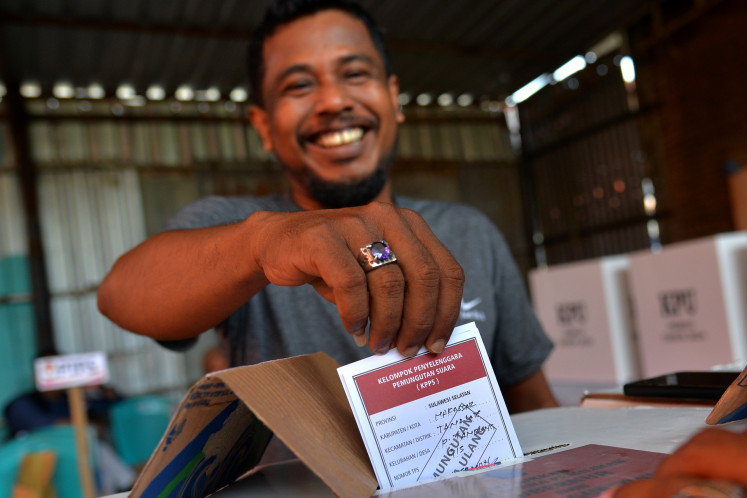Popular Reads
Top Results
Can't find what you're looking for?
View all search resultsPopular Reads
Top Results
Can't find what you're looking for?
View all search resultsBoyonz Ilyas takes local textiles to the stage
A long skirt portraying the map of IndonesiaIndonesia’s lengthy evolution through age-old traditions has further enriched its artistic culture, which includes traditional textiles with a variety of motifs, patterns, and colors and unique production techniques
Change text size
Gift Premium Articles
to Anyone
A long skirt portraying the map of Indonesia
Indonesia’s lengthy evolution through age-old traditions has further enriched its artistic culture, which includes traditional textiles with a variety of motifs, patterns, and colors and unique production techniques.
The beauty and richness of Indonesian textiles have inspired local fashion designer Boyonz Ilyas to create glamorous designs and display 48 outfits in a solo fashion show called “Glamorous Khatulistiwa”.
Boyonz, who has been in the fashion business for 25 years, is a co-founder of the Association of Indonesian Batik Lovers. He was named best designer (Fashion TV - Paris) during the Bali Fashion Week in 2001.
At a recent fashion show in the Lobby Lounge of Shangri-la Hotel Jakarta, he exposed traditional textiles from many regions across the country.
He, for instance, displayed a variety of beautiful batik, ranging from West Java’s Cirebon, Yogyakarta, Central Java’s Solo and Tegal, and East Java’s Madura and Tuban.
Some touches of western Indonesia appear in a series of woven textiles with embroidery called songket. It includes songket from Pandeksikek, Palembang and Lampung.
Boyonz said he planned to preserve the traditional songket making, which is done by hand. Otherwise it could vanish given the rapidly changing pace of modern Indonesia. Older generations still make songket by hand and take months to make one length of the fabric.
Songket by hand is not easy to produce and is increasingly rare nowadays, as younger generations tend to use modern machines, which are more practical.
A hooded gown with batik detailing
The designer, who graduated from Yogyakarta-based Indonesia Arts Institute (ISI), also brought in hand embroidery from Lampung and Minangkabau’s famous kaluakpaku motives.
Tenun (woven cloth) from eastern parts of Indonesia like Bali, Sumba and Lombok could also be seen in his collections.
In his latest collections, Boyonz combined the Indonesian textiles with international fabrics, such as French lace, taffeta and Dutch satin. He also incorporated beads, stones and sequins in his creations.
Gamis (long skirt) dominated the fashion show.
“Gamis used to be mainly used for Muslim wear, but the cloth can actually be worn by everyone. It is simple, comfortable and suitable for any occasion,” said Boyonz after the show.
Take a long pink skirt, which was combined with songket and black lace its hem and both wrists.
A long red skirt with songket along the button line looked sophisticated with obi and kimono sleeves, while a dark brown tunic with the classic batik style along the button line gave a mysterious nuance.
Eyelet patterns were also showcased in the show. A long brown skirt, for instance, was combined with bell-shaped sleeves and a matching songket fabric on the chest. Another item was a long brown skirt with balloon sleeves and tenun on the chest.
In a section, Boyonzs displayed the exoticism of kebaya, matching it with various fabrics and adding a lot of details.
A green French lace kebaya, for instance, was matched with songket, while a skin-colored kebaya was paired with a sexy bustier and batik from the northern coastal of Java.
Another design was a black kebaya with a lot of embroidery, which was matched with a calf-length batik skirt.
Besides women’s wear, Boyonz also designed a number of attractive men’s wear items.
A touch of batik on men’s wear
The casual look could be seen through a combination of a navy blue t-shirt and batik pants.
For men who want to be different, Boyonz created a selection of sophisticated clothes to choose from.
Take a tenun shirt with a blazer and Moroccan pants or a brown blazer with a batik sarong and a tenun shawl.
The designer also seemed in the mood to revive a Sumatran look by matching jackets with woven sarongs and pants.
In some ways, however, his efforts in putting things together in a design seemed contradictory, since it ended up “burying” the real beauty of the traditional textiles.
The unique motives of batik, for instance, were hidden by the flashy lacy kebaya, which was full of embroidery and sequins.
However, Boyonz’s big intentions and attempt to preserve local heritage are worth a round of applause.
— Photos courtesy of Shangri-la Hotel












